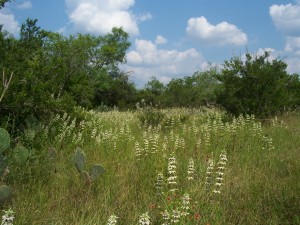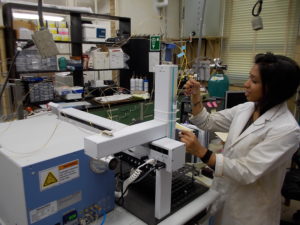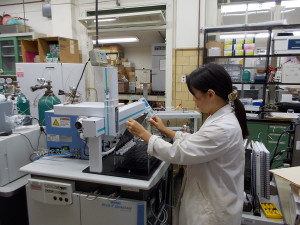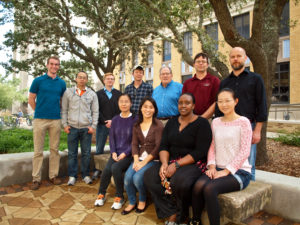Woody plant encroachment into grasslands: Impacts on landscape-scale 3-dimensional spatial patterns of soil C, N, and P storage.
Stable isotope partnership for ecology, environment, and energy research
Biogeochemical consequences of land cover and land uses in juniper-oak savannas of the southern Great Plains.
Identifying sources of N2O production in agroecosystems: A step towards more effective mitigation
 Woody plant encroachment into grasslands: Impacts on landscape-scale 3-dimensional spatial patterns of soil C, N, and P storage and dynamics.
Woody plant encroachment into grasslands: Impacts on landscape-scale 3-dimensional spatial patterns of soil C, N, and P storage and dynamics.
2016-2018. NSF Ecosystem Studies Program, Dissertation Research, DEB-1600790 (T. Boutton and Y. Zhou).
 Modification of soil nutrient pool sizes following woody plant proliferation has long been of interest to grassland, savanna, and desert ecologists. However, most previous studies examining nutrient dynamics following woody encroachment have been confined to small spatial scales, limited to the uppermost portions of the soil profile, and focused primarily on C and/or N. This research will quantify soil organic C, total N, and total P throughout the entire soil profile in order to make the first assessment of landscape-scale C:N:P soil stoichiometry following woody plant encroachment into grassland. Specific objectives are: (1) Examine whether vegetation cover change alters the 3-dimensional spatial patterns of soil C, N, and P storage at the landscape scale; and (2) Test whether soil P scales isometrically with respect to C and N, and whether these isometric patterns change with soil depth in N-fixer encroached systems. Nutrient stores will be quantified in spatially-specific soil cores taken to a depth of 1.2 meters in a subtropical savanna landscape in southern Texas where N-fixing woody plants have encroached into grasslands during the past century. Results will offer new perceptions on the effects of woody encroachment on interactions between C, N, and P cycles in arid and semi-arid ecosystems across the globe, and enhance our ability to represent these interactions in linked biogeochemistry-climate models.
Modification of soil nutrient pool sizes following woody plant proliferation has long been of interest to grassland, savanna, and desert ecologists. However, most previous studies examining nutrient dynamics following woody encroachment have been confined to small spatial scales, limited to the uppermost portions of the soil profile, and focused primarily on C and/or N. This research will quantify soil organic C, total N, and total P throughout the entire soil profile in order to make the first assessment of landscape-scale C:N:P soil stoichiometry following woody plant encroachment into grassland. Specific objectives are: (1) Examine whether vegetation cover change alters the 3-dimensional spatial patterns of soil C, N, and P storage at the landscape scale; and (2) Test whether soil P scales isometrically with respect to C and N, and whether these isometric patterns change with soil depth in N-fixer encroached systems. Nutrient stores will be quantified in spatially-specific soil cores taken to a depth of 1.2 meters in a subtropical savanna landscape in southern Texas where N-fixing woody plants have encroached into grasslands during the past century. Results will offer new perceptions on the effects of woody encroachment on interactions between C, N, and P cycles in arid and semi-arid ecosystems across the globe, and enhance our ability to represent these interactions in linked biogeochemistry-climate models.
 Stable isotope partnership for ecology, environment, and energy research
Stable isotope partnership for ecology, environment, and energy research
2016-2020. Texas A&M University Research Development Fund (E. Grossman, B. Roark, T. Boutton, N. Slowey, J. West, A. Hyodo)
This project funds the acquisition of two major instruments: a gas chromatograph combustion-isotope ratio mass spectrometer system (GC-C-MS-IRMS), and a clumped isotope mass spectrometer (CIMS). These instruments provide unique analytical capabilities at the forefront of ecology and the biogeosciences. These capabilities will be developed jointly through the partnership of the Stable Isotopes for Biosphere Science (SIBS) Laboratory in the College of Agriculture and Life Sciences, and the Stable Isotope Geosciences Facility (SIGF) in the College of Geosciences. The GC-C-MS-IRMS instrument enables simultaneous separation and identification of specific biochemical compounds using gas chromatography/quadrupole mass spectrometry, followed by determination of their isotopic composition (15N, 13C, 2H) through a combustion or pyrolysis interface to an IRMS. This system will provide cutting-edge methods to track sources and fates of specific biochemical compounds (e.g., alkanes, lipids, amino acids) through the biosphere, geosphere, hydrosphere, and atmosphere, expanding interpretations of bulk isotopic measurement. This instrument will be housed in the SIBS Laboratory. The clumped isotope mass spectrometer (CIMS) measures the concentration of mole cules with two rare isotopes, for example, 13C18O16O/12C16O2. This ratio in carbonate rocks and minerals is temperature dependent, providing a geothermometer for the pore-filling carbonate cements that occlude porosity and permeability in carbonate petroleum reservoirs. Moreover, with burial of carbonate rocks, these clumped isotope signatures reset and provide burial temperatures essential for petroleum exploration. Clumped isotopes are also an emerging methodology in paleoclimate studies in soil science, geology, and oceanography. In addition, this instrumentation would also provide triple oxygen isotope analysis (18O/16O, 17O/16O), an emerging tracer for hydrologic and atmospheric research. The CIMS will be housed at SIGF. Together, these two new instruments will catalyze new research ventures in the biogeosciences.
cules with two rare isotopes, for example, 13C18O16O/12C16O2. This ratio in carbonate rocks and minerals is temperature dependent, providing a geothermometer for the pore-filling carbonate cements that occlude porosity and permeability in carbonate petroleum reservoirs. Moreover, with burial of carbonate rocks, these clumped isotope signatures reset and provide burial temperatures essential for petroleum exploration. Clumped isotopes are also an emerging methodology in paleoclimate studies in soil science, geology, and oceanography. In addition, this instrumentation would also provide triple oxygen isotope analysis (18O/16O, 17O/16O), an emerging tracer for hydrologic and atmospheric research. The CIMS will be housed at SIGF. Together, these two new instruments will catalyze new research ventures in the biogeosciences.
 Biogeochemical consequences of land cover and land uses in juniper-oak savannas of the Southern Great Plains.
Biogeochemical consequences of land cover and land uses in juniper-oak savannas of the Southern Great Plains.
2018-2021. Sid Kyle Long-Term Savanna Research and Education Initiative (T. Boutton, R. Mushinski, J. Hsiao, C. Casola).
 In grasslands and savannas of the southern Great Plains region, herbivory and fire are likely to interact with woody plant encroachment to alter ecosystem biogeochemistry by influencing above- and belowground primary production, and the structure and function of soil microbial communities. The purpose of this study is to quantify how fire and herbivory treatments interact with vegetation cover to influence: (1) stores of soil organic C, total N, and total P, and (2) the composition and functional abilities of soil microbial communities. Research will be conducted on the western portion of the Edwards Plateau where oak and juniper are encroaching into southern mixed grass prairie. To assess how disturbance treatments interact with vegetation to affect soil organic matter, we will characterize soil C, N, and P pool sizes within each major vegetation type in the herbivory/fire treatments and control exclosures. Soil sampling will be conducted where primary production data will be collected so that soil C-N-P responses can be explicitly paired with herbaceous and woody productivity rates. High-resolution, color infrared aerial photographs will be obtained and georeferenced for each treatment combination to link belowground measurements with aboveground vegetation. Soil and root samples will be analyzed for organic C, total N, and total P. Analyses of δ13C and δ15N in soils, roots, and litter will offer insights regarding mechanisms responsible for altering C, N, and P pool sizes, and enable calculations of soil organic matter turnover rates. For each of the treatment and control plots, we will assess the structural and functional attributes of the soil microbial community. Aliquots of each soil sample will be used to determine microbial biomass by fumigation-extraction. Microbial community composition will be determined by extracting soil DNA from another soil aliquot, and subjecting it to a phylogenetic survey whereby the 16S ribosomal subunit will be analyzed to characterize bacteria and archaea, and the ITS region to characterize fungi using the Illumina MiSeq platform. Results will indicate number and relative abundances of operational taxonomic units present, and will yield functional information based on known characteristics of the species present. Given the vast geographic extent of woody encroachment into grasslands, savannas, and other dryland ecosystems at the global scale, results from this study will improve our ability to incorporate the biogeochemical consequences of land cover/land use changes into coupled climate–biogeochemistry models to enhance our understanding of the earth system.
In grasslands and savannas of the southern Great Plains region, herbivory and fire are likely to interact with woody plant encroachment to alter ecosystem biogeochemistry by influencing above- and belowground primary production, and the structure and function of soil microbial communities. The purpose of this study is to quantify how fire and herbivory treatments interact with vegetation cover to influence: (1) stores of soil organic C, total N, and total P, and (2) the composition and functional abilities of soil microbial communities. Research will be conducted on the western portion of the Edwards Plateau where oak and juniper are encroaching into southern mixed grass prairie. To assess how disturbance treatments interact with vegetation to affect soil organic matter, we will characterize soil C, N, and P pool sizes within each major vegetation type in the herbivory/fire treatments and control exclosures. Soil sampling will be conducted where primary production data will be collected so that soil C-N-P responses can be explicitly paired with herbaceous and woody productivity rates. High-resolution, color infrared aerial photographs will be obtained and georeferenced for each treatment combination to link belowground measurements with aboveground vegetation. Soil and root samples will be analyzed for organic C, total N, and total P. Analyses of δ13C and δ15N in soils, roots, and litter will offer insights regarding mechanisms responsible for altering C, N, and P pool sizes, and enable calculations of soil organic matter turnover rates. For each of the treatment and control plots, we will assess the structural and functional attributes of the soil microbial community. Aliquots of each soil sample will be used to determine microbial biomass by fumigation-extraction. Microbial community composition will be determined by extracting soil DNA from another soil aliquot, and subjecting it to a phylogenetic survey whereby the 16S ribosomal subunit will be analyzed to characterize bacteria and archaea, and the ITS region to characterize fungi using the Illumina MiSeq platform. Results will indicate number and relative abundances of operational taxonomic units present, and will yield functional information based on known characteristics of the species present. Given the vast geographic extent of woody encroachment into grasslands, savannas, and other dryland ecosystems at the global scale, results from this study will improve our ability to incorporate the biogeochemical consequences of land cover/land use changes into coupled climate–biogeochemistry models to enhance our understanding of the earth system.
 Identifying sources of N2O production in agroecosystems: A step towards more effective mitigation.
Identifying sources of N2O production in agroecosystems: A step towards more effective mitigation.
2013-2016. Texas A&M AgriLife Air Quality Research Program (J. West, T.W. Boutton, F.M. Hons, J. Sparks).
 Nitrous oxide (N2O) is among the most powerful greenhouse gases, with a heat-holding capacity 300x greater than CO2 on a per molecule basis, and an atmospheric residence time >100 yrs. Its concentration is now increasing exponentially due to human industrial and agricultural activities. In agricultural lands, such as croplands and rangelands, N2O is produced by soil microorganisms during the processes of nitrification and denitrification. Because the conditions and management activities that favor nitrification versus denitrification are significantly different and quite complex, it is necessary to be able to quantify and distinguish these two N2O sources in order to develop more effective strategies to mitigate the production rates associated with each source. Although croplands and rangelands strongly dominate the land cover of Texas, our understanding of both the identity and rates of the soil processes that produce N2O in these systems remains limited. We will employ a powerful new “isotopomer” methodology that allows the separation of specific soil microbial processes (nitrification vs. denitrification) responsible for N2O production in two important agricultural systems in Texas. This unique approach relies on the fact that N2O produced by nitrification has a significantly different intramolecular arrangement of natural N and O isotopes compared to N2O derived from denitrification. The N2O molecule has a linear structure of the form Nβ=Nα=O which also equilibrates with Nβ≡Nα−O. The basis for the proposed research rests on the fact that microbially-mediated reactions involved in denitrification result in 15N enrichment at the central Nα relative to the terminal Nβ, while reactions during nitrification result in smaller 15N discrimination between the central Nα and the terminal Nβ. Thus, by determining the intramolecular isotopic composition of N2O, the relative contributions of nitrification vs. denitrification to the soil N2O flux can be fingerprinted and quantified. We will integrate a PreCon/GasBench system with one of our isotope ratio mass spectrometers, develop sample preparation protocols, and then produce initial assessments of N2O sources in: (a) a long-term (> 30 year) agricultural experiment studying crop rotation, tillage and fertilizer effects on soil processes, and (b) a rangeland ecosystem with well-described changes in N cycling driven by invasion of N-fixing tree legumes.
Nitrous oxide (N2O) is among the most powerful greenhouse gases, with a heat-holding capacity 300x greater than CO2 on a per molecule basis, and an atmospheric residence time >100 yrs. Its concentration is now increasing exponentially due to human industrial and agricultural activities. In agricultural lands, such as croplands and rangelands, N2O is produced by soil microorganisms during the processes of nitrification and denitrification. Because the conditions and management activities that favor nitrification versus denitrification are significantly different and quite complex, it is necessary to be able to quantify and distinguish these two N2O sources in order to develop more effective strategies to mitigate the production rates associated with each source. Although croplands and rangelands strongly dominate the land cover of Texas, our understanding of both the identity and rates of the soil processes that produce N2O in these systems remains limited. We will employ a powerful new “isotopomer” methodology that allows the separation of specific soil microbial processes (nitrification vs. denitrification) responsible for N2O production in two important agricultural systems in Texas. This unique approach relies on the fact that N2O produced by nitrification has a significantly different intramolecular arrangement of natural N and O isotopes compared to N2O derived from denitrification. The N2O molecule has a linear structure of the form Nβ=Nα=O which also equilibrates with Nβ≡Nα−O. The basis for the proposed research rests on the fact that microbially-mediated reactions involved in denitrification result in 15N enrichment at the central Nα relative to the terminal Nβ, while reactions during nitrification result in smaller 15N discrimination between the central Nα and the terminal Nβ. Thus, by determining the intramolecular isotopic composition of N2O, the relative contributions of nitrification vs. denitrification to the soil N2O flux can be fingerprinted and quantified. We will integrate a PreCon/GasBench system with one of our isotope ratio mass spectrometers, develop sample preparation protocols, and then produce initial assessments of N2O sources in: (a) a long-term (> 30 year) agricultural experiment studying crop rotation, tillage and fertilizer effects on soil processes, and (b) a rangeland ecosystem with well-described changes in N cycling driven by invasion of N-fixing tree legumes.
